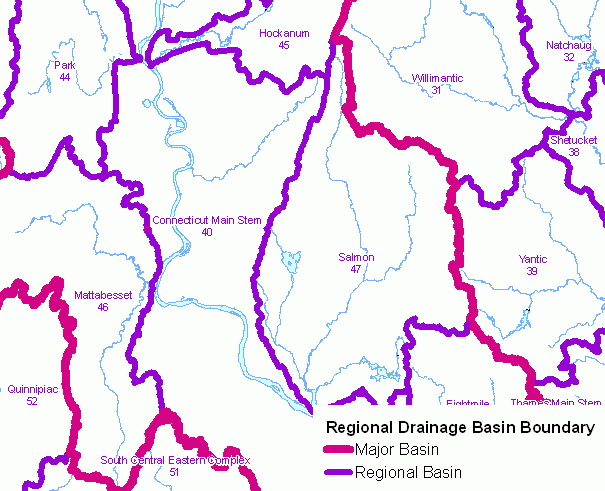
A standardized mapping of natural drainage basins in Connecticut was completed in 1981 by the Connecticut Department of Environmental Protection (DEP). This drainage basin system divided Connecticut into 8 major basins, 45 regional basins, 337 subregional basins, 2,898 local basins, and 7,067 small drainage basin areas. The statewide mapping of natural drainage basins established a hierarchical system of basins based on drainage area size with large major basins subdivided into regional basins, regional basins subdivided into subregional basins, subregional basins subdivided into local basins, and local basins subdivided into smaller and more numerous drainage basin areas. It includes watersheds for Connecticut rivers, streams, brooks, lakes, reservoirs and ponds included on 1:24,000-scale 7.5 minute topographic quadrangle maps published by the U.S. Geological Survey (USGS) between 1969 and 1984. These basin units include smaller watersheds that drain into many of the small streams and ponds in Connecticut. These basin areas are the building blocks for the larger local, subregional, regional and major drainage basins defined by DEP.
Connecticut Regional Drainage Basin includes 43 drainage basin areas, the majority of which range from 40 to 400 square miles in size and make up the larger major drainage basin areas. The regional basin number (RBAS_NO) uniquely identifies individual basins and is 2 characters in length. There are 44 unique regional basin numbers. Examples include 43 for the Farmington River Regional Basin, 60 for the Housatonic River Main Stem Regional Basin, and 61 for the Blackberry River Regional Basin. The first digit (column 1) designates the major basin and the first two digits (columns 1-2) designate the regional basin. Note, there are slightly more regional basin areas delineated (85) than unique regional basin numbers (44) due to coastal regional basins defined by series of areas located along the Connecticut shoreline. Refer to the Connecticut Regional Drainage Basin GIS metadata for more information about drainage basin numbers.
These basin boundaries are the digital equivalent of the major and regional drainage basin boundaries published on the 1:125,000-scale state map entitled Natural Drainage Basins in Connecticut, McElroy, 1981.
A drainage basin is an area of land where water from rain or snow melt drains downhill into a body of water such as a river, lake, wetland or ocean. The drainage basin includes both the streams and rivers that convey the water as well as the land surface from which water drains into those channels. Used as the basis for DEP drainage basin mapping, a natural drainage basin is one in which the outlet point is a natural occurring feature. These outlet points occur at stream confluences, stream outfalls into waterbodies, and impoundments.
The hierarchical system of drainage basin delineation and numbering, as implemented by DEP, allow for the association of the physical resources to the naturally occuring drainage system that covers Connecticut. This information can be used to determine where rainfall naturally flows over the land and downstream to a particular watercourse. It can be used to identify the upstream contributing watershed for a point along a river, stream, reservoir, lake, or pond. And for cataloging purposes, a drainage basin identifier can be associated with any location on land or water in Connecticut.
Drainage basin boundaries were manually delineated by interpreting the 10 foot contour lines and hydrography features shown on USGS 1:24,000-scale topographic quadrangle maps. The horizontal positional accuracy of this information is consistent with other 1:24,000-scale hydrography related data such as Connecticut Hydrography, Connecticut Waterbody, Connecticut Named Waterbody and Connecticut Surface Water Quality Classification. Only limited field checking was conducted to verify the location of these basin boundaries. Basin boundaries may not be accurate in areas that have been diked for flood control, upland wetland and reservoirs having outlets into two basins, and areas where topographic mapping is not up to date, is inaccurate, or is not detailed enough to adequately define local drainage. Residential and commercial development, highway construction, and other changes to the landscape may have resulted in local modifications to the natural drainage pattern since the time these basin boundaries were delineated.